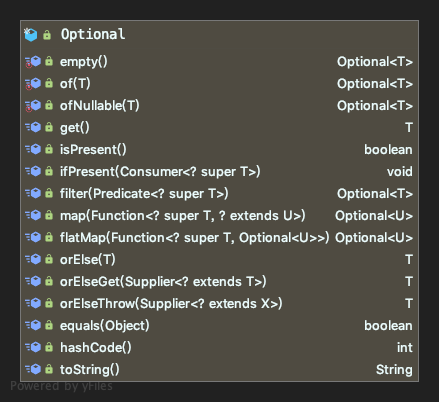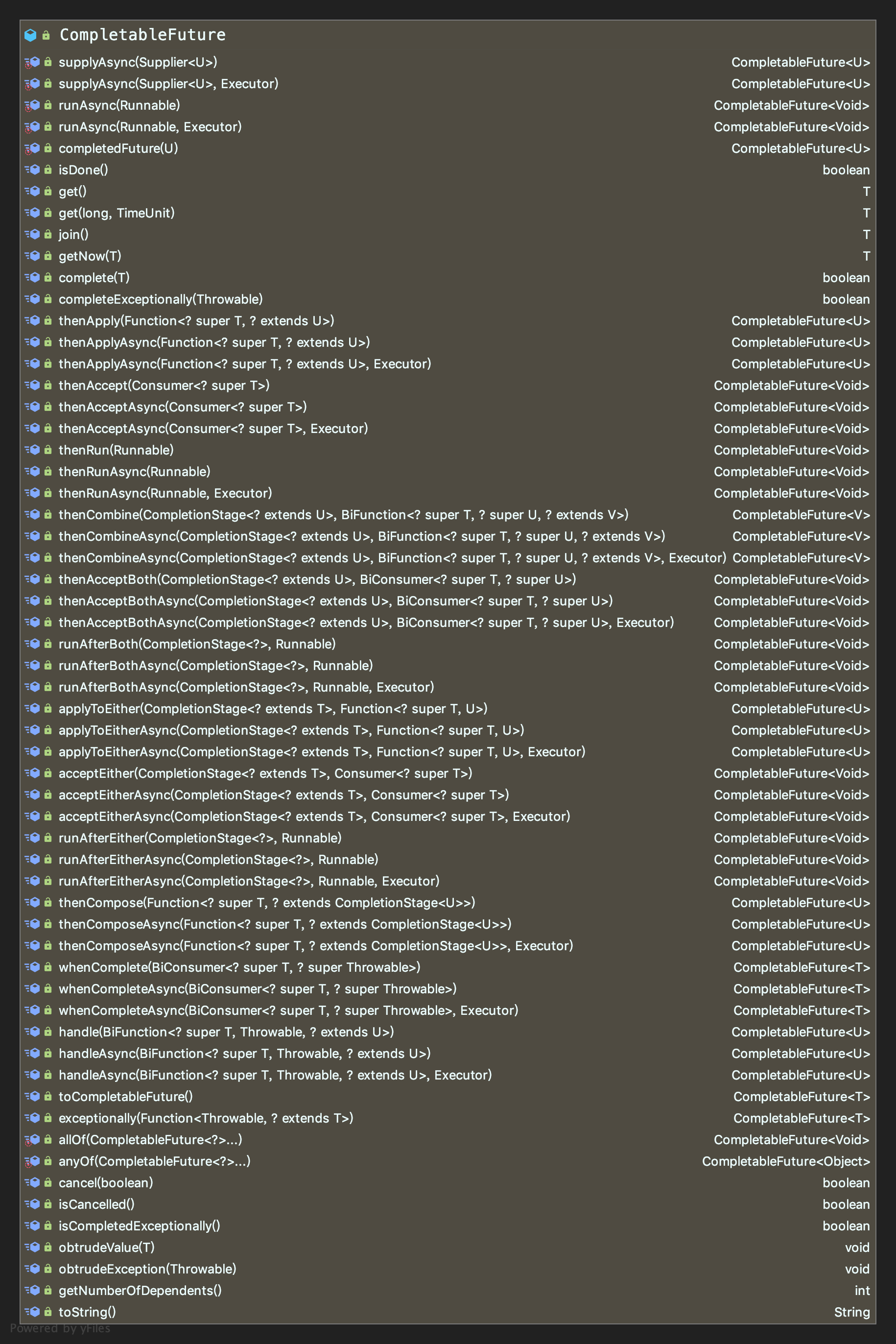怎样用Java 8优雅的开发业务
目录
函数式编程
流式编程
基本原理
在Java中流式编程的基本原理有两点。
- 构建流
- 数据流转(流水线)
- 规约
IntStream.rangeClosed(1, 100) // 1. 构建流
.mapToObj(String::valueOf)// 2. 数据流转(流水线)
.collect(joining()); // 3. 规约
案例
- 英雄的主位置一共有几类,分别是什么
@Test
fun t1() {
// 英雄的主位置一共有几类,分别是什么
// 映射
val roleMains = heroes.map(Hero::getRoleMain)
// 过滤为空的数据
.filter(Objects::nonNull)
// 去重
.distinct()
println(roleMains.size)
println(roleMains)
}
@Test
public void t1() {
// 英雄的主位置一共有几类,分别是什么
List<String> roleMains = heroes.stream()
// 映射
.map(Hero::getRoleMain)
// 过滤为空的数据
.filter(Objects::nonNull)
// 去重
.distinct()
// 收集列表
.collect(toList());
System.out.println(roleMains.size());
System.out.println(roleMains);
}
- 英雄按主次位置分组后,输出每个分组有多少英雄,其中:近战英雄有多少位,远程英雄有多少位
@Test
fun t2() {
// 英雄按主次位置分组后,输出每个分组有多少英雄,其中:近战英雄有多少位,远程英雄有多少位
// 主次位置分组的英雄数量
val groupHeroCount = heroes.groupingBy {
Pair.of(it.roleMain, it.roleAssist)
}.eachCount()
// 主次分组后,再按攻击范围分组的英雄数量
val groupThenGroupCount = heroes.groupBy {
Pair.of(it.roleMain, it.roleAssist)
}.map {
val value = it.value.groupingBy(Hero::getAttackRange).eachCount()
Pair.of(it.key, value)
}.associateBy({ it.left }, { it.value })
// 遍历输出
groupThenGroupCount.forEach { (groupKey, groupValue) ->
val groupingCount = groupHeroCount[groupKey]
print("英雄分组key为:$groupKey;英雄数量:$groupingCount;")
groupValue.forEach { (countKey, countValue) ->
print("英雄攻击范围:$countKey;英雄数量:$countValue;")
}
println()
}
}
@Test
public void t2() {
// 英雄按主次位置分组后,输出每个分组有多少英雄,其中:近战英雄有多少位,远程英雄有多少位
// 主次位置分组的英雄数量
Map<Pair<String, String>, Long> groupHeroCount = heroes.stream()
.collect(groupingBy(hero -> Pair.of(hero.getRoleMain(), hero.getRoleAssist()), counting()));
// 主次分组后,再按攻击范围分组的英雄数量
Map<Pair<String, String>, Map<String, Long>> groupThenGroupCount = heroes.stream()
.collect(groupingBy(hero -> Pair.of(hero.getRoleMain(), hero.getRoleAssist()),
groupingBy(Hero::getAttackRange, counting())));
// 遍历输出
groupThenGroupCount.forEach((groupKey, groupValue) -> {
Long groupingCount = groupHeroCount.get(groupKey);
System.out.print("英雄分组key为:" + groupKey + ";英雄数量:" + groupingCount + ";");
groupValue.forEach((countKey, countValue) -> System.out.print("英雄攻击范围:" + countKey + ";英雄数量:" + countValue + ";"));
System.out.println();
});
}
- 求近战英雄HP初始值的加总
@Test
fun t3() {
// 求近战英雄HP初始值的加总
val sum = heroes.filter { "近战" == it.attackRange }
.map(Hero::getHpStart)
.filter(Objects::nonNull)
.reduce(BigDecimal::add)
println("近战英雄HP初始值的加总为:$sum")
}
@Test
public void t3() {
// 求近战英雄HP初始值的加总
BigDecimal sum = heroes.stream()
.filter(hero -> "近战".equals(hero.getAttackRange()))
.map(Hero::getHpStart)
.filter(Objects::nonNull)
.reduce(BigDecimal.ZERO, BigDecimal::add);
System.out.println("近战英雄HP初始值的加总为:" + sum);
}
- 通过最小列表收集器获取最小列表
@Test
public void t4() {
// 通过最小列表收集器获取最小列表
List<BigDecimal> minAttackGrowth = heroes.stream()
.map(Hero::getAttackGrowth)
.collect(new MinListCollector<>());
System.out.println(minAttackGrowth);
List<Hero> minHero = heroes.stream()
.collect(new MinListCollector<>());
System.out.println(minHero);
}
import java.util.*;
import java.util.concurrent.atomic.AtomicReference;
import java.util.function.BiConsumer;
import java.util.function.BinaryOperator;
import java.util.function.Function;
import java.util.function.Supplier;
import java.util.stream.Collector;
import java.util.stream.Collectors;
import static java.util.stream.Collector.Characteristics.*;
/**
* 最小列表收集器
*
* @author switch
* @since 2020/8/18
*/
public class MinListCollector<T extends Comparable<? super T>> implements Collector<T, List<T>, List<T>> {
/**
* 收集器的特性
*
* @see Characteristics
*/
private final static Set<Characteristics> CHARACTERISTICS = Collections.unmodifiableSet(EnumSet.of(IDENTITY_FINISH));
private final static int ZERO = 0;
/**
* 最小值
*/
private final AtomicReference<T> min = new AtomicReference<>();
@Override
public Supplier<List<T>> supplier() {
// supplier参数用于生成结果容器,容器类型为A
return ArrayList::new;
}
@Override
public BiConsumer<List<T>, T> accumulator() {
// accumulator用于消费元素,也就是归纳元素,这里的T就是元素,它会将流中的元素一个一个与结果容器A发生操作
return (list, element) -> {
// 获取最小值
T minValue = min.get();
if (Objects.isNull(minValue)) {
// 第一次比较
list.add(element);
min.set(element);
} else if (element.compareTo(minValue) < ZERO) {
// 发现更小的值
list.clear();
list.add(element);
min.compareAndSet(minValue, element);
} else if (element.compareTo(minValue) == ZERO) {
// 与最小值相等
list.add(element);
}
};
}
@Override
public BinaryOperator<List<T>> combiner() {
// combiner用于两个两个合并并行执行的线程的执行结果,将其合并为一个最终结果A
return (left, right) -> {
// 最小值列表合并
List<T> leftList = getMinList(left);
List<T> rightList = getMinList(right);
leftList.addAll(rightList);
return leftList;
};
}
private List<T> getMinList(List<T> list) {
return list.stream()
.filter(element -> element.compareTo(min.get()) == ZERO)
.collect(Collectors.toList());
}
@Override
public Function<List<T>, List<T>> finisher() {
// finisher用于将之前整合完的结果R转换成为A
return Function.identity();
}
@Override
public Set<Characteristics> characteristics() {
// characteristics表示当前Collector的特征值,这是个不可变Set
return CHARACTERISTICS;
}
}
优雅的空处理

import org.junit.Test;
import java.util.Optional;
/**
* @author switch
* @since 2020/8/18
*/
public class OptionalTests {
@Test
public void t1() {
// orElse
System.out.println(Optional.ofNullable(null).orElse("张三"));
System.out.println(Optional.ofNullable(null).orElseGet(() -> "李四"));
System.out.println(Optional.ofNullable("王五").orElseThrow(NullPointerException::new));
}
@Test
public void t2() {
// isPresent
Optional<String> name = Optional.ofNullable("张三");
if (name.isPresent()) {
System.out.println(name.get());
}
}
@Test
public void t3() {
// map
Optional<Integer> number = Optional.of("123456").map(Integer::valueOf);
if (number.isPresent()) {
System.out.println(number.get());
}
}
@Test
public void t4() {
// flatMap
Optional<Integer> number = Optional.of("123456").flatMap(s -> Optional.of(Integer.valueOf(s)));
if (number.isPresent()) {
System.out.println(number.get());
}
}
@Test
public void t5() {
// 过滤
String number = "123456";
String filterNumber = Optional.of(number).filter(s -> !s.equals(number)).orElse("654321");
System.out.println(filterNumber);
}
}
新的并发工具类CompletableFuture

单机批处理多线程执行模型
该模型适用于百万级量级的任务。超过千万数据,可以考虑分组,多机器并行执行。
基本流程:
- 从数据库获取Id列表
- 拆分成n个子Id列表
- 通过子Id列表获取关联数据(注意:都需要提供批量查询接口)
- 映射到需要处理的Model(提交到CompletableFuture)->处理数据->收集成list)(java 8流式处理)
- 收集的list进行join操作
- 收集list
模型
模型原理:Stream+CompletableFuture+lambda
简要解释:
- CompletableFuture是java8提供的一个工具类,主要是用于异步处理流程编排的。
- Stream是java8提供的一个集合流式处理工具类,主要用于数据的流水线处理。
- lambda在java中是基于内部匿名类实现的,可以大幅减少重复代码。
- 总结:在该模型中Stream用于集合流水线处理、CompletableFuture解决异步编排问题(非阻塞)、lambda简化代码。
- 数据流动
List<List<String>> ->
Stream<List<String>> ->
Stream<List<Model>> ->
Stream<CompletableFuture<List<Model>>> ->
Stream<CompletableFuture<List<映射类型>>> ->
List<CompletableFuture<Void>>
案例
ThreadPoolUtil
import org.springframework.scheduling.concurrent.ThreadPoolTaskExecutor;
import java.util.concurrent.ThreadPoolExecutor;
public final class ThreadPoolUtil {
public static ThreadPoolTaskExecutor getDefaultExecutor(Integer poolSize, Integer maxPoolSize, Integer queueCapacity) {
ThreadPoolTaskExecutor executor = new ThreadPoolTaskExecutor();
executor.setAllowCoreThreadTimeOut(true);
executor.setWaitForTasksToCompleteOnShutdown(true);
executor.setCorePoolSize(poolSize);
executor.setMaxPoolSize(maxPoolSize);
executor.setQueueCapacity(queueCapacity);
executor.setRejectedExecutionHandler(new ThreadPoolExecutor.CallerRunsPolicy());
return executor;
}
}
ThreadPoolConfig
import org.springframework.context.annotation.Bean;
import org.springframework.context.annotation.Configuration;
import org.springframework.scheduling.concurrent.ThreadPoolTaskExecutor;
@Configuration
public class ThreadPoolConfig {
/**
* 计算规则:N(thread) = N(cpu) * U(cpu) * (1 + w/c)
* N(thread):线程池大小
* N(cpu):处理器核数
* U(cpu):期望CPU利用率(该值应该介于0和1之间)
* w/c:是等待时间与计算时间的比率,比如说IO操作即为等待时间,计算处理即为计算时间
*/
private static final Integer TASK_POOL_SIZE = 50;
private static final Integer TASK_MAX_POOL_SIZE = 100;
private static final Integer TASK_QUEUE_CAPACITY = 1000;
@Bean("taskExecutor")
public ThreadPoolTaskExecutor taskExecutor() {
return ThreadPoolUtil.getDefaultExecutor(TASK_POOL_SIZE, TASK_MAX_POOL_SIZE, TASK_QUEUE_CAPACITY);
}
}
#getFuturesStream
public Stream<CompletableFuture<List<Model>>> getFuturesStream(List<List<String>> idSubLists) {
return idSubLists.stream()
.map(ids ->
CompletableFuture.supplyAsync(() -> modelService.listByIds(ids), taskExecutor)
);
}
#standardisation
public void standardisation() {
List<CompletableFuture<Void>> batchFutures = getFuturesStream(idSubLists)
.map(future -> future.thenApply(this::listByNormalize))
.map(future -> future.thenAccept(modelService::batchUpdateData))
.collect(Collectors.toList());
List<Void> results = batchFutures.stream()
.map(CompletableFuture::join)
.collect(Collectors.toList());
}
调整线程池的大小
《Java并发编程实战》一书中,Brian Goetz和合著者们为线程池大小的优化提供了不少中肯的建议。这非常重要,如果线程池中线程的数量过多,最终它们会竞争稀缺的处理器和内存资源,浪费大量的时间在上下文切换上。反之,如果线程的数目过少,正如你的应用所面临的情况,处理器的一些核可能就无法充分利用。Brian Goetz建议,线程池大小与处理器的利用率之比可以使用下面的公式进行估算:
$$N_{threads} = N_{CPU} * U_{CPU} * (1 + \frac{W}{C})$$其中:
- $N_{CPU}$是处理器的核的数目,可以通过
Runtime.getRuntime().availableProcessors()得到- $U_{CPU}$是期望的CPU利用率(该值应该介于0和1之间)
- $\frac{W}{C}$是等待时间与计算时间的比率,比如说IO操作即为等待时间,计算处理即为计算时间
并行——使用流还是CompletableFutures?
对集合进行并行计算有两种方式:要么将其转化为并行流,利用map这样的操作开展工作,要么枚举出集合中的每一个元素,创建新的线程,在CompletableFuture内对其进行操作。后者提供了更多的灵活性,可以调整线程池的大小,而这能帮助确保整体的计算不会因为线程都在等待I/O而发生阻塞。
使用这些API的建议如下:
- 如果进行的是计算密集型的操作,并且没有I/O,那么推荐使用Stream接口,因为实现简单,同时效率也可能是最高的(如果所有的线程都是计算密集型的,那就没有必要创建比处理器核数更多的线程)。
- 反之,如果并行的工作单元还涉及等待I/O的操作(包括网络连接等待),那么使用CompletableFuture灵活性更好,可以依据等待/计算,或者$\frac{W}{C}$的比率设定需要使用的线程数。这种情况不使用并行流的另一个原因是,处理流的流水线中如果发生I/O等待,流的延迟特性很难判断到底什么时候触发了等待。
日期和时间API

使用指南:https://www.yuque.com/docs/share/ee5ef8a7-d261-4593-bd08-2a7a7d2c11ca?#(密码:gtag) 《时区工具类使用指南》
项目地址
GitHub:java8-fluent
参考
分享并记录所学所见